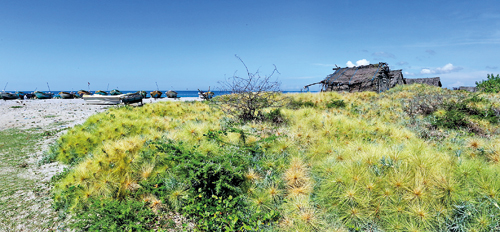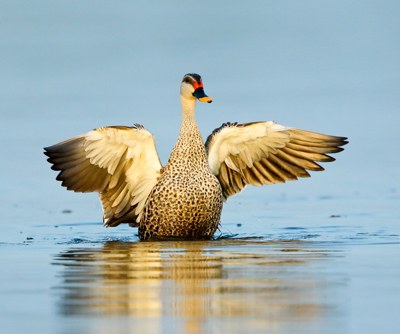Savour and save the beauty of Mannar: A clarion call through pictures

Mannar: A land of rugged beauty
Northern Sri Lanka’s beauty eluded the third eye of nature photographers for a long time because of security issues. But with restrictions eased after the war, well known wildlife photographers Thilak Jayaratne, Janaka Gallangoda and Nadika Hapuarachchi became frequent visitors to this region. The beauty of Mannar and Adam’s Bridge sand islands mesmerised these photographers and after a gruelling five-year effort, they compiled their experiences into a coffee table book ‘Mannar Unbound’ with the assistance of Tamara Fernando.
‘Mannar Unbound’ is a result of their extensive field work documenting the flora and fauna of the region. The book spans a variety of photographic genres including avian photography, landscapes, underwater fauna and architectural ruins. Capturing the images on this challenging terrain requires infinite patience to follow trails, waiting patiently at nesting sites and often taking bumpy rides on a rough sea. The photographers had to visit the same sites repeatedly to photograph during different seasons – Nadeeka Hapuarachchi recollects the experience on behalf of the team of authors.
Some images of the book are worthy of special mention. These include photographs of species of pelagic seabirds in the Sand Islands, the critically endangered Dugong and some choice underwater treasures.However, “Mannar Unbound” is not just a collection of photographs as this visual story is intertwined with a historical story exploring the times of Portuguese, Dutch and British colonial periods. The book goes further down in history telling Mannar’s tale from the glorious days of the Anuradhapura kingdom. It recollects how ‘Mahatiththa’ (Great Port) – as Mannar was known in ancient times –allowed Sri Lanka’s great kings to reap the benefits of the ancient Maritime Silk Route. The book then explores Mannar’s iconic pearl fishery and Robert Knox’s famous accounts of the region.
Adam’s Bridge, that consist of eight sand islands under Sri Lankan territories is the only recorded location in Sri Lanka to have nesting sites for several species of pelagic sea birds. The photographers made many visits to photograph birds in these unique islands. They recall their experiences:
“Sea birds used to congregate on the third island of Adam’s Bridge National Park for their annual nesting season. When you approach the third island the first observation one makes is a mesmerizing low-set dark cloud hovering over the island, that happens to be large flocks of pelagic birds in multitudes, jostling each other to feed their hatchlings. If you were to compel a bit closer, the next encounter is a deafening cacophony of chicks and adults.”
The book recollects the mystical beauty of these sand islands. “It feels like you have this uninhibited piece of paradise all to yourself. During high tide nature puts on an extraordinary display, filling the basins of the islands with gushing sea water, which gives an appearance of the Amazon river basin on aerial photographs. The scenery melts effortlessly from white sandy beaches and gentle undulations of sand dunes to verdant salt marshes. I can happily spend the whole day here, watching from a vantage point at endless turquoise water crashing against deserted white sand shores,” one account states.

Indian Spot-billed Duck
There are lots of coffee table books capturing the terrestrial animals. Rarely are there are books that capture the beauty of the ocean’s depths. But the photographers of ‘Mannar Unbound’ even dived to capture its unique marine biodiversity and even managed to photograph a dugong – the most critically endangered mammal in Sri Lanka.
Mannar island is only a part of Mannar District, but if you have a closer look, it reveals a region that is also home to dry riverine forests, damana grasslands and dry monsoon forests. The book also portrays photos taken in other parts of Mannar District such as Madhu Sanctuary and Giant’s Tank.
“The leaves are still dripping from an overnight downpour when Janaka slings on his day pack and heads out into the river on a day with a damp morning chill. It is just after the daybreak and already the Madhu Forest is alive with hoots and chatter. A strange ululating chant starts up in the distance, fades out then builds again. ‘Listen! says Janaka, grabbing my arm and cocking one ear, that is a ‘Ulama’, can you hear? There are two of them, singing a duet”- the authors beautifully reconstruct their experience elsewhere in Mannar District in the chapter ‘Magic of Monsoon’.
“Photographs in this book freeze moments in time. But the story of Mannar is dynamic, cosmopolitan and changing even as the book goes to print. While our photographic stills capture images of beauty, they are threatened daily by encroaching industry, aggressive tourism and poor resource management. Mannar Unbound is a clarion call to savour the beauty of the region and to assist, urgently in its preservation” ‘Mannar Unbound’ concludes.
With nearly 300 breathtaking photographs that span nearly 400 pages, ‘Mannar Unbound’ is priced at Rs.9000, but there is a pre-publication offer of Rs.6500 until December 9. The ‘Mannar Unbound’ photographic exhibition portraying some of the work in the book will be held at the Lionel Wendt Art Gallery on December 8 and 9. The exhibition is open to the public.


